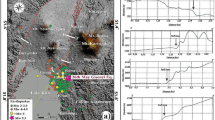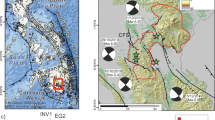Abstract
Considering the lack of site effect cartography in the Iberian Peninsula region to be related to the strong motion data, we present a site amplification factor map covering the Iberian Peninsula and the Balearic Islands. Steps leading to produce the map have included the classification of geological units from the 1:1,000,000 scale Geological Map of Spain into six site classes characterized on a seismic response basis, and the calculation, for every site class, of both short-period and mid-period amplification factors. In order to test the validity and applicability of the map, we have calculated the synthetic seismic intensity in the particular localities where several past earthquakes were felt, supposing a point source approximation. The synthetic intensities have been obtained with and without site amplification factors, resulting in two types of synthetic isoseismals maps that have been compared with the corresponding observed isoseismals. As the amplification factors obtained are only applicable to the linear domain, the synthetic intensities greater than VII are only illustrative. A main conclusion has been drawn about the fact that synthetic isoseismals with site amplification factor approach to the related observed isoseismals in a higher degree than synthetic isoseismals without site amplification factor. In addition, the resemblances between the synthetic isoseismals produced with site amplification factors and the corresponding observed isoseismals have been found to be more evident at shorter epicentral distances, provided that intensities are lower than VIII, and therefore, we remain in the linear domain.







Similar content being viewed by others
References
Borcherdt RD (1994) Estimates of site-dependent response spectra for design (methodology and justification). Earthq Spectra 10:617–653
Building Seismic Safety Council (1998) 1997 Edition NEHRP Recommended provisions for the development of seismic regulations for new buildings and other structures. FEMA 302. Building Seismic Safety Council, Washington
Building Seismic Safety Council (2003) NEHRP Recommended provisions for seismic regulations for new buildings and other structures (FEMA 450). 2003 Edition. Part 1: provisions. Building Seismic Safety Council, Washington
Dirección General de Protección Civil and Dirección General del Instituto Geográfico Nacional (2002) Estimación rápida preliminar de daños potenciales en España por terremotos. Simulación de Escenarios Sísmicos SES 2002. Manual técnico. Dirección General de Protección Civil, Madrid (in Spanish)
Instituto Geográfico Nacional (2010) Catálogo de terremotos. Geographical Institute of Spain (Instituto Geográfico Nacional) website http://www.ign.es/ign/layoutIn/sismoFormularioCatalogo.do. Accessed 26 May 2010 (in Spanish)
Instituto Geológico y Minero de España (1994) Mapa Geológico de España a escala 1:1.000.000. CD, Instituto Geológico y Minero de España, Madrid (in Spanish)
International Council of Building Officials (1997) Uniform building code. International Council of Building Officials, Whittier
Martínez Solares JM and Mezcua J (2002) Catálogo sísmico de la Península Ibérica (880 a.C.-1900), Monografía núm. 18. Dirección General del Instituto Geográfico Nacional, Madrid (in Spanish)
Mezcua J (1982) Catálogo general de isosistas de la Península Ibérica, Publicación 202. Instituto Geográfico Nacional, Madrid (in Spanish)
Mezcua J, Rueda J, García Blanco RM (2004) Reevaluation of historic earthquakes in Spain. Seismol Res Lett 75:75–81
Ministerio de Fomento (2003) Norma de Construcción Sismorresistente: Parte general y edificación (NCSE-02). Ministerio de Fomento, Madrid (in Spanish)
Moratto L, Suhadolc P, Costa G (2011) ShakeMaps for three relevant earthquakes in the Southeastern Alps: comparison between instrumental and observed intensities. Tectonophysics 509:93–106
Panza GF, Craglietto A and Suhadolc P (1991) Source geometry of historical events retrieved by synthetic isoseismals. In: Stucchi M, Postpischl D (eds) Multidisciplinary evaluation of historical earthquakes. Tectonophysics 193:173–184
Rey Pastor A (1936) Sismicidad de las regiones litorales españolas del Mediterráneo II. Región Bética y Subbética. Géologie de la Méditerranée Occidentale IV:1–46 (in Spanish)
Sirovich L (1996a) Synthetic isoseismals of two Californian earthquakes. Nat Hazards 14:23–37
Sirovich L (1996b) A simple algorithm for tracing synthetic isoseismals. Bull Seismol Soc Am 86:1019–1027
Tsige M and García Flores I (2006) Riesgo sísmico en la Región de Murcia (RISMUR). Volumen 2: Caracterización geotécnica y análisis de efecto local. Dirección General del Instituto Geográfico Nacional and Consejería de Presidencia de la Región de Murcia, Madrid (in Spanish)
Wald DJ, Quitoriano V, Heaton TH, Kanamori H, Scrivner CW, Worden CB (1999) TriNet “ShakeMaps”: rapid generation of peak ground motion and intensity maps for earthquakes in southern California. Earthq Spectra 15:537–555
Acknowledgments
The preparation of this paper has constituted part of the activities carried out by Alberto Núñez as a grant holder of the IGN. We are grateful to José Antonio Chapinal from the IGN, who helped us prepare part of Figs. 3, 4, 5, 6 and 7. We really appreciate all the help given by the GEOI + D Research Centre, belonging to the Technical University of Madrid (Universidad Politécnica de Madrid, UPM), as well as the support of Antonio Vázquez and Rosa García Blanco from the UPM. Finally, we would like to thank the two anonymous reviewers for their contributions.
Author information
Authors and Affiliations
Corresponding author
Rights and permissions
About this article
Cite this article
Núñez, A., Rueda, J. & Mezcua, J. A site amplification factor map of the Iberian Peninsula and the Balearic Islands. Nat Hazards 65, 461–476 (2013). https://doi.org/10.1007/s11069-012-0375-2
Received:
Accepted:
Published:
Issue Date:
DOI: https://doi.org/10.1007/s11069-012-0375-2




